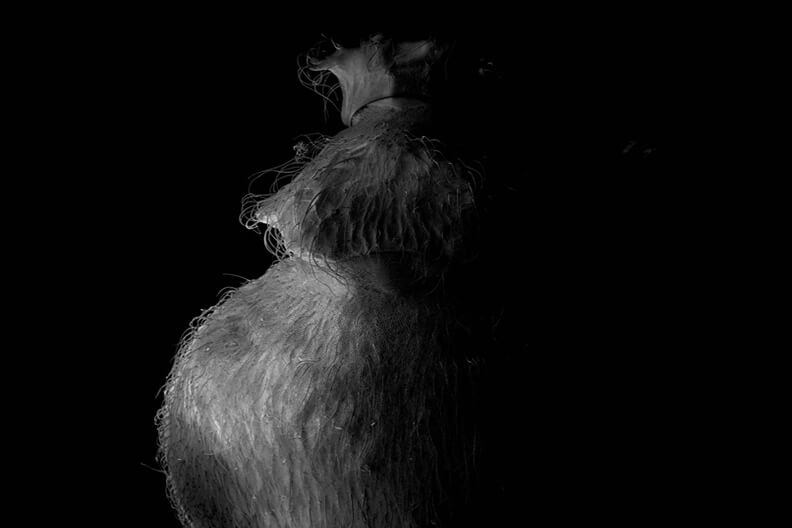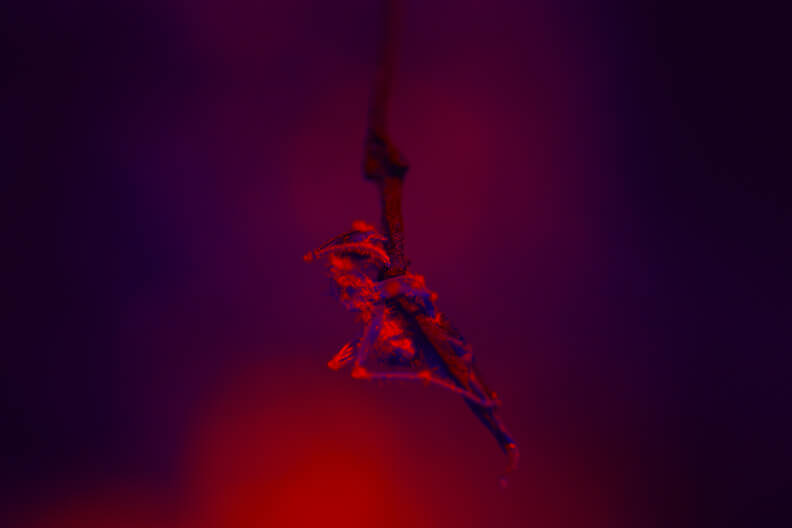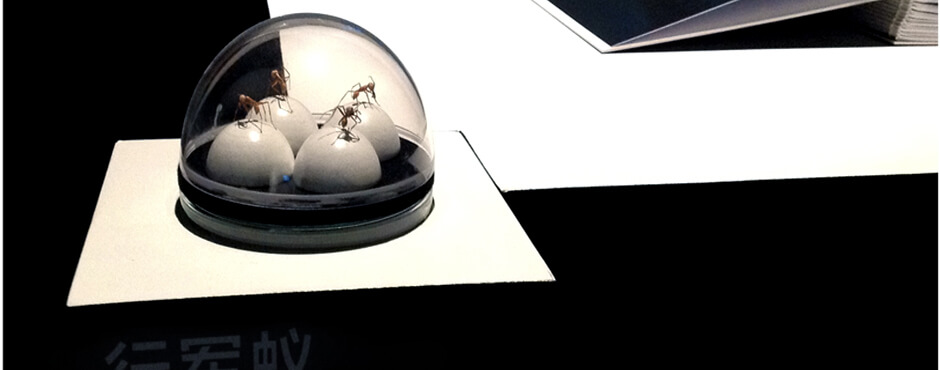Interview by Ana Sancho

Humans have always been fascinated with ants and their social behaviour. These creatures have commonly been the focus of science fiction movies and comics, striking at that great human fear – the possibility of being dominated. The level of social organization of these animals, each of them with specialized roles and surviving as a collective organism, makes them one of the most extraordinary and inspiring creatures.
This fascination with ants is what led Ecuadorian artist Kuai Shen to start performing experiments with ant colonies. He had his first encounter with army ants in the Ecuadorian rainforest; since then, these insects have become his source of inspiration and the subject around which his work revolves.
One of his first studies, 0h!m1gas, already revealed the complexity behind Shen’s installations. For this project, an ant colony dictated the movement of a needle on a vinyl record so that the insects become the creators of sounds, resembling the stridulatory vibrations that ants use as communication signals. This responsive environment explores the phenomena of self-organization in ant societies and fantasises about the possibility of interaction between humans and ants.
Shen drills down a little deeper to examine the phenomena of parasitism, both from a biological and technological point of view, in the interdisciplinary project Viral Ecologies: technological hypnotism and the zombie ants. A parasitic fungus that settles in the brains of certain species – controlling their minds with a chemical cocktail in its survival interest – lays the ground for further exploration of the social similarities between ants and humans. Perhaps the two organisms have more in common in terms of decision-making, problem-solving, and behavioural manipulation than we think.
His last installation is based on the social thermoregulation of redwood ants in the Baltic forests. Thermotaxis is a reactive soundscape that celebrates the crucial role of these organisms in preserving ecosystems, interacting with other species, hibernating and changing the properties of the soil.
All of Shen’s work outlines the importance of social networking and its biological implications, using ants as superorganism models. After all, if ants are key to understanding social dominance, they may shed light on that defining trait of human nature [1].
[1] http://digitalartistresidency.org/kuai-shen


Your work involves complex living systems (ants) that you associate to certain human behaviours and human-generated concepts (from games to cybernetics). How and when did the fascination with them come about?
It all started in the year 2000 when I was doing volunteering work for an indigenous community, a Quechua native tribe in Cuyabeno, located in the northern region of the Ecuadorian Amazon, as part of my bachelor studies. I stayed in an encampment one hour away by foot from the tribe’s settlement. I felt so lucky to had that experience.
Every day I walked the path there, I was confronted by the magic of “pacha mama” and by the most fascinating insects you could imagine. I became very aware of ants, as never before. That’s where I learned about the swarm. I observed so many different ants sharing space, tolerating each other, and battling for territory at the same time.
The most exciting was the army ants, Eciton burchellii. They create living bridges with their bodies to cross over water ponds; they interconnect themselves to build a living architecture as a temporary nest, known as a bivouac, which is guarded by fierce and relentless soldiers. Back then, I imagine them as the first aliens colonizing Earth.
When they marched, an uncanny silence reigned in the forest. Birds started flying, spiders crawled away, and every creature from the soil, even reptiles and small mammals, would try to hide or escape the marching swarm. I fell in love with them. I started writing science fiction stories about ants and other insects.
Even though I had seen ants crawling everywhere in my parent’s house in the city where I grew up, I never really paid close attention to them until that time in the rainforest. Funny though, ants were always in the houses where I was living, and I move a lot in Ecuador.
I felt they were following me; I didn’t know back then, but they were appearing before my eyes for a reason. And that reason was revealed years later when I started a project about ants and holography at the Academy of media arts in Cologne entitled, 1.ant.ity. Throughout my postgraduate studies there, I focused on interconnecting media theories with ant-inspired audiovisual experiments.
Your projects are considerably complex. 0h!m1gas, for example, is a sound-reactive installation inspired by the turntable’s functional resemblance as an artefact for sound production in human culture with ants’ stridulatory organ. In it, you use turntables and video cameras interfaced with a computer vision program. What were the biggest challenges you faced in its development?
There were two major challenges. Firstly, letting go of the idea of control. Secondly, trust someone else to take care of your colony when you’re not around. Ants, particularly leaf-cutter ants, are extremely malleable in terms of adapting to constrained spaces. Yet the colony is perceived and cared for as a single living being that keeps growing and growing as long as you provide them with the right conditions and regular fresh leaves.
This means they always manage to find a way out from time to time because the increasing number in ants tends to increase the need for space exponentially, which makes you reconsider keeping ants in captivity. Once you present ants within an artist’s context, it becomes an issue to maintain and see the colony as a part of an artwork because the unpredictability of ants running free in a gallery is problematic for curators and visitors.
As a biology student, I was fascinated by how ant-infecting fungi were able to control the insect’s behaviour for their own reproduction purposes. In your project ´viral ecologies: technologic hypnotism and the zombie ants´. Could you tell us a bit about the intellectual process behind it?
The idea originated as part of a project I created, Ecologias Virales, for my residency at Universidad Nacional in Bogotá in 2014. I was reading at the time Tony D. Sampson’s book, Virality: Contagion Theory in the Age of Networks, which inspired me to start a new interdisciplinary experiment, including do-it-together workshops, on the transmission of viruses and the social contagion which affect both ants and humans.
More importantly, his book introduced me for the first time to the writings of Gabriel Tarde, a fascinating French sociologist who described the importance of imitation in society. Maybe the following quote enlightens a bit the inspiration I drew from the book: »The inseparability of the ever-circulating repetitions of mechanical desires and the often illusory sense that our choices and decisions belong to us, as Tarde had already contended, make the social a hypnotic state: »a dream of command and a dream of action« in which the somnambulist is »possessed by the illusion that their ideas, all of which have been suggested to them, are spontaneous«.
Additionally, I always wanted to do something with the zombie ants; basically, zombie ants are created by a parasitic fungus, Cordyceps unilateralis, which infects several tropical ants in South American forests, including genera such as Camponotus, Paraponera and Azteca. This is still an ongoing project and research, which I’m developing with the aim to materialize as a multi-disciplinary project, i.e., installation/publication/workshop/performance. You can take a peek here (this took place as part of a series of online artistic residencies led by Tom Milnes.
What are the main observations regarding human behaviour you’ve obtained by working with ants and reflecting on their interaction and mimicry with human culture?
It suits me well to extend my previous answer in order to answer this question. There’s a thing called the superorganism, which I like to relate to my work. In terms of myrmecology, the pioneer of this theory was William Morton Wheeler back in 1910 with his book, Ants: Their Structure, Development and Behavior. Now, I like chaos and the generation of apparent order from it as perceived and described by humans. When you see ants swarming out of their nest or Sufi rituals like this one, what exactly do you see?
That is where the first, second and third waves of cybernetics come into play. We cannot help but seek order in the phenomena we observe. The subject, the effects, self-organization, networks, automated algorithms, and artificial or organic emergence are all interconnected, and yet they do not necessarily have to be. Isolation helps us understand that which originally is indescribable. We abstract and reconstruct in favour of that which is familiar to us.
To this extent, we have seen ants as this magnificent example of social life, but they can be bewildering, unpredictable, and strangers to the analogies and gestalt imposed by our brains; in other words, ants are nonhumans. Exploring and revealing this duality is part of my quest, audiovisual experiences which demonstrate relation and conflict.
It shows how the human brain works, like an ant colony: so many possibilities. If you fast forward to the nineties, and connect all these with the superorganism in ants described by E.O. Wilson and Bert Holldöbler, then you can embrace social behaviour as repetitions that create innovation based on the social contagion, forces which perpetually act upon us along evolutionary encounters between species.
What directions do you see taking your work into?
I definitely see my artistic research with ants crossing into other disciplines like anthropology, politics and particular game theory. I would go so far as to suggest ant mimicry could hold the key to understanding social mimicry in the broader sense as a model for individual behaviour and the personal decisions taken based on context-specific rules of conduct in conflict situations.
Moreover, what I would really like to seek is for my ant research to be acknowledged as a form of the holistic social model, which can be applied to understanding any form of social behaviour on the planet. If you contemplate a time-lapse of life on Earth, from single organisms to complex ones, we all end up getting together at one point or another, affecting and influencing each other, either as communities, groups, temporal organizations or colonies. In the end, it is all about being or becoming social.
What is your chief enemy of creativity?
Hierarchical timelines.
You couldn’t live without…
Ants and coffee.






